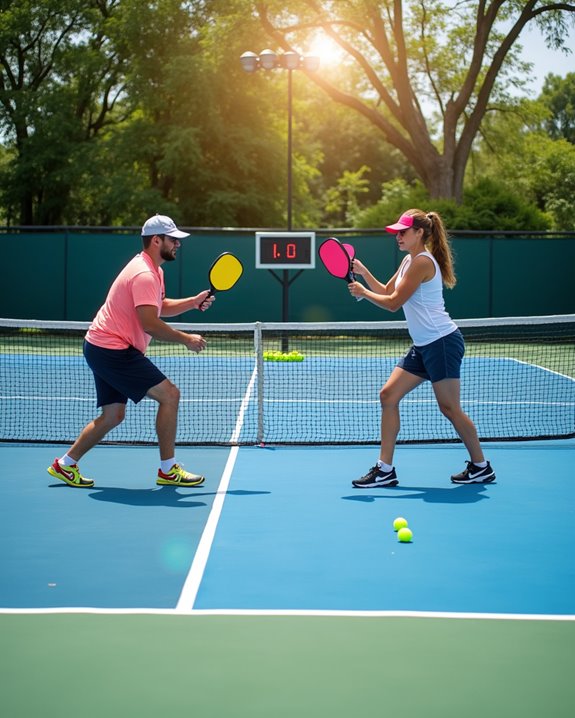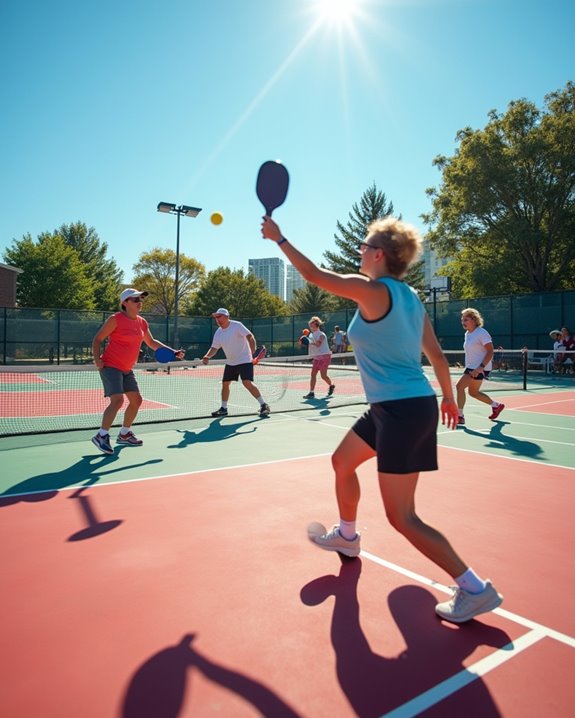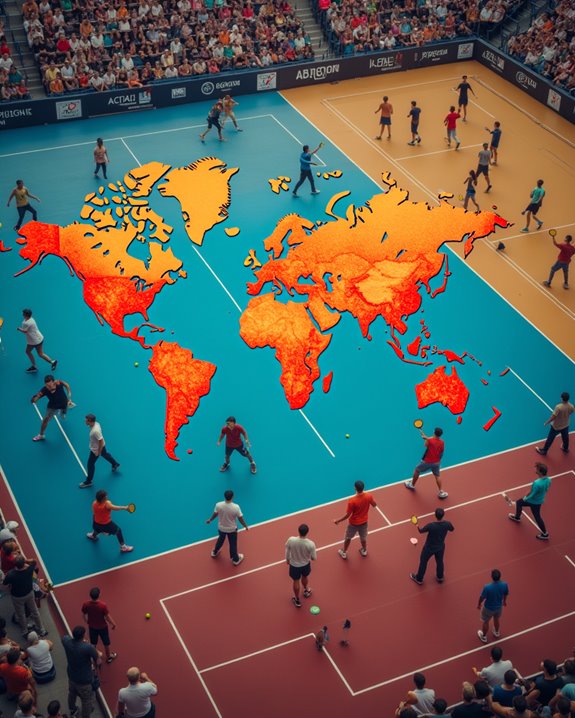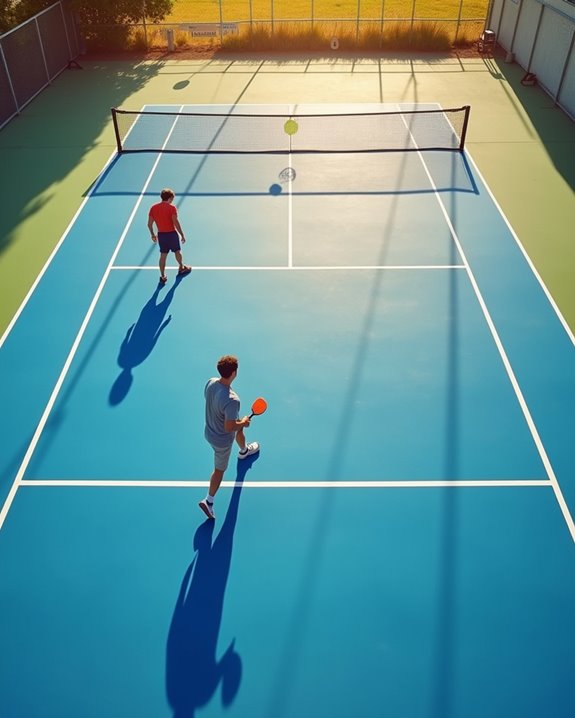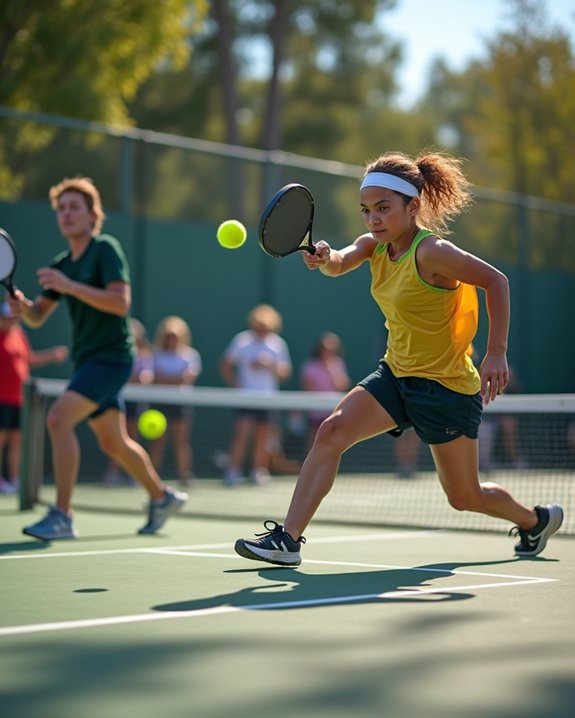Pickleball’s basic rules include playing on a 20′ × 44′ court with a 36″ net (34″ at center). You’ll need an approved paddle and ball to play. Serve underhand diagonally into your opponent’s court, and remember the two-bounce rule: the ball must bounce once on each side after serving before volleys are allowed. Games go to 11 points (win by 2), and you can only score when serving. Master the kitchen (non-volley zone) restrictions to enhance your pickleball potential.
Key Takeaways
- Serves must be underhand with the paddle below the wrist and one foot behind the baseline.
- The two-bounce rule requires the ball to bounce once on each side after serving before volleys are allowed.
- Non-volley zone (kitchen) extends 7 feet from the net where players cannot hit volleys while standing inside.
- Games are played to 11 points (win by 2), with only the serving team able to score points.
- Court dimensions are 20 feet wide by 44 feet long, with a net height of 36 inches at sides and 34 inches in middle.
9 Second-Level Headings for “Official Pickleball Rules for Beginners in 2025”
A roadmap through the pickleball rulebook can help you digest the game’s essentials without getting overwhelmed. When organizing your beginner’s guide, simmer down the complexity with these essential headings: “USA Pickleball Official Equipment Rules” (covering approved pickleball paddles and balls), “Serving Fundamentals” (explaining how the serving team initiates play), “The Two-Bounce Rule” (clarifying why the ball must bounce once on each side), “Kitchen Etiquette” (navigating the non-volley zone like a pro), and “Understanding Faults” (identifying when a fault occurs).
Don’t forget to fold in “Safety Provisions” as your final section – the 2025 rulebook has freshly whisked these guidelines to guarantee players of all levels can enjoy the game without getting burned.
Understanding the Pickleball Court Layout and Dimensions
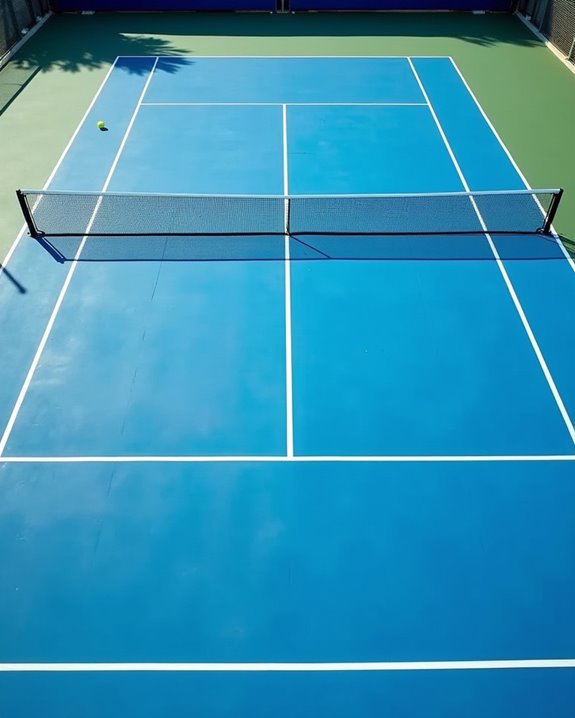
The pickleball court serves as your kitchen stadium where all the action unfolds. You’ll be playing on a 20-foot-wide by 44-foot-long rectangle that’s perfectly sized for both singles and doubles competition. The court’s centerpiece is the net, which stands 36 inches tall at the sidelines and dips to 34 inches in the middle—like a perfectly draped tablecloth.
The non-volley zone (affectionately called “the kitchen”) extends 7 feet from the net on both sides, creating a no-fly zone for volleys. Your service area is divided diagonally, with right-side serves for even scores and left-side for odd ones. Remember, the lines are your friends—they’re in-play for all shots except when serving, where your serve must completely clear the kitchen line.
Essential Equipment Requirements for Beginners
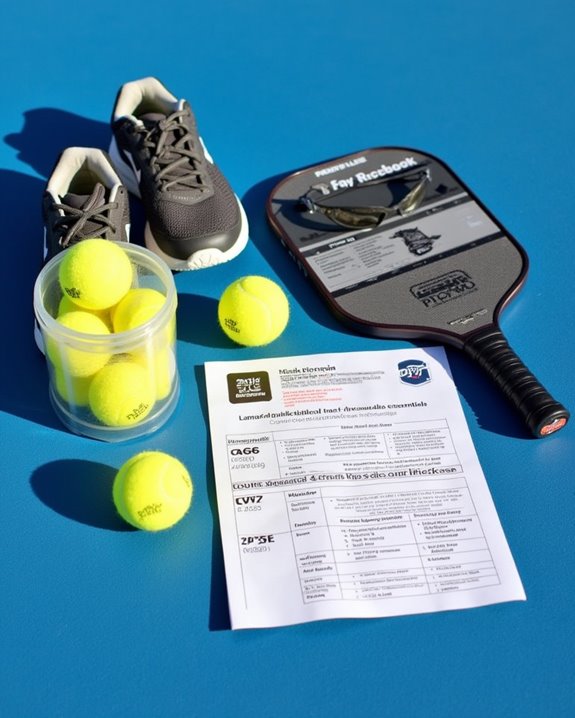
Now that you’re familiar with the kitchen’s layout, let’s outfit you with the right cooking tools to serve up pickleball success!
Your essential ingredients start with a USA Pickleball-approved paddle—over 1,225 varieties exist that meet standard specifications. Pair this with an official ball (81 approved types available) to guarantee your game follows regulation. Don’t skimp on appropriate athletic shoes that provide traction on the playing surface—they’re as vital as non-slip shoes in a busy kitchen! Additionally, consider selecting paddles made from high-quality materials to enhance your performance on the court.
Remember that court dimensions (20′ x 44′) and net height (34″ at center) create the perfect recipe for play. While permanent nets are the gold standard, portable nets work wonderfully for beginner equipment setups and casual matches. These portable options let you whip up a pickleball court almost anywhere!
Serving Rules and Techniques for New Players
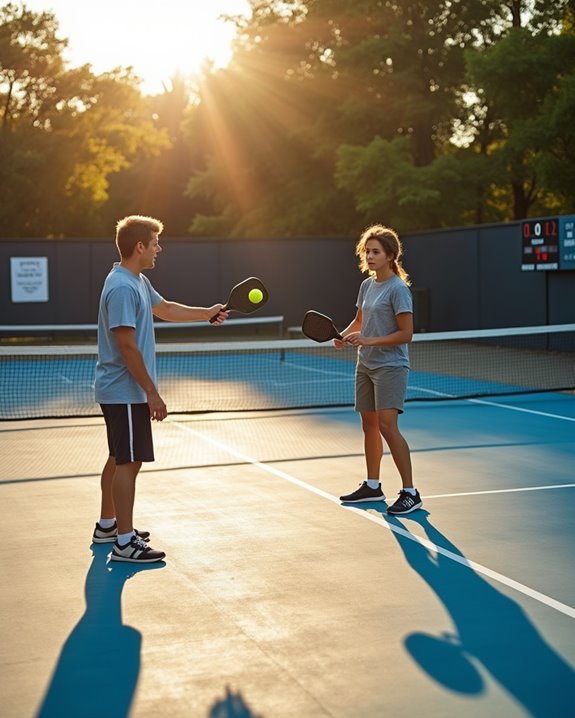
Serving in pickleball resembles tossing the perfect salad—it’s all about technique and proper form! According to official rules, you must use an underhand motion, keeping your paddle below your wrist when contact occurs. Think of it as folding ingredients gently rather than vigorously whisking!
The underhand serve: pickleball’s gentle art of folding the ball into play with finesse rather than force.
You’ll need one foot behind the baseline when serving, and your ball must land diagonally in your opponent’s service area. Miss the mark? That’s a fault—just like overcooking a soufflé. No second chances here!
After you score points, your serving team switches court sides. Remember, the first serve always starts from the right side—like plating from right to left.
Need an alternative? Try the drop serve! Simply drop the ball, let it bounce, then serve it up!
The Two-Bounce Rule Explained
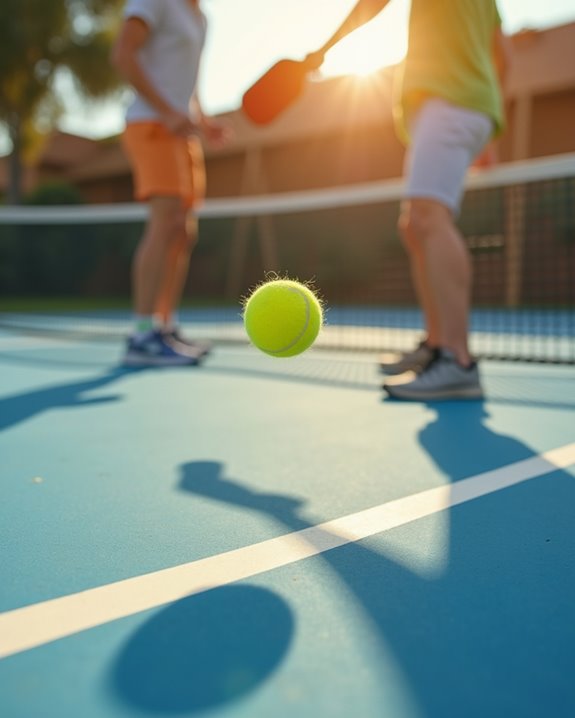
After mastering your serve, you’ll encounter what many players call “pickleball’s secret sauce” – the two-bounce rule! This official regulation requires that the ball must bounce once on each side of the court after the serve before players can volley the ball.
When you’re serving, your opponents must let the ball bounce before returning it. Then, your team must also allow it to bounce on your side before hitting back. It’s like letting a soufflé set before diving in!
This rule guarantees fair play while keeping beginners from camping at the kitchen (non-volley zone). Once both bounces are complete, you’re free to volley and spice up your strategic play! Remember, patience during these initial bounces will serve up better positioning for the rally ahead.
Non-Volley Zone (Kitchen) Regulations and Common Violations
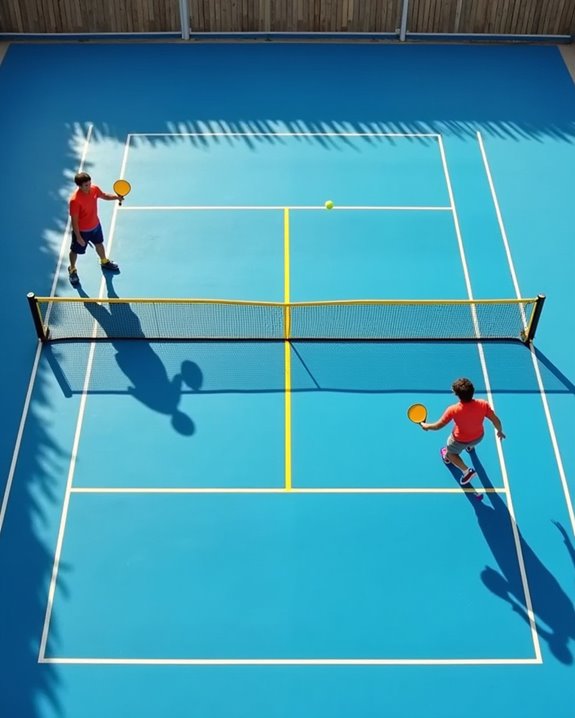
While many areas of the pickleball court are your playground, the kitchen—officially called the non-volley zone—comes with a special recipe of rules you’ll need to master!
This 7-foot zone extending from the net is where volleys are strictly off the menu. You’ll commit a fault if you hit the ball out of the air while standing in or touching the kitchen line. Think of it as a hot surface you can’t touch during certain plays!
You can enter the kitchen to retrieve a bounced ball, but your momentum after a volley must never carry you into this forbidden area. Remember, during a serve, the ball must land beyond the opponent’s kitchen—touching the line counts as a short serve and costs you points. Keep your feet positioned carefully to avoid getting burned!
Scoring System and How to Keep Track of Points
Once you’ve mastered the kitchen rules, you’ll need to learn how to count the calories—I mean points—in pickleball! The traditional scoring system only allows the serving team to score points when the opposing team commits a fault. Games are played to 11 points, but you must win by 2, creating a delicious tension when scores simmer at 10-10.
In singles pickleball, you’ll serve from the right court when your score is even and left when odd. For doubles, track points using a three-number sequence that’s as layered as a good lasagna. Remember, every serve must clear the non-volley zone before landing in your opponent’s court. Like a chef monitoring multiple pots, keeping track of points requires focus—especially when rallies heat up!
Doubles Play: Positioning and Partner Strategy
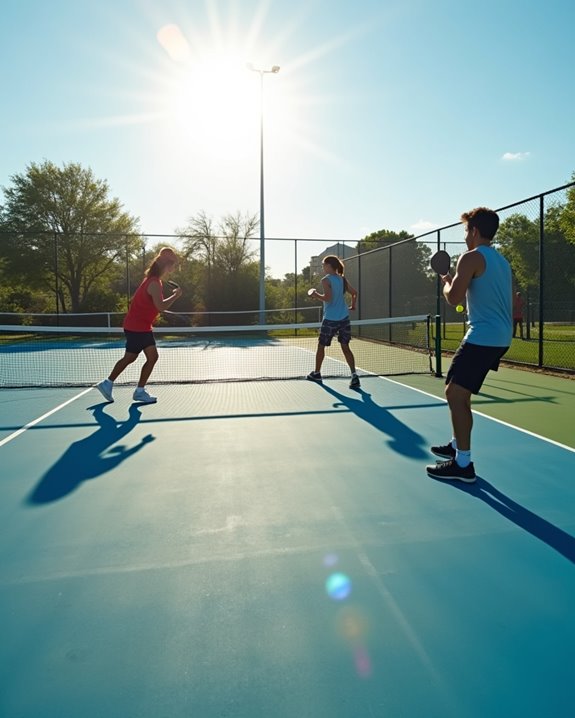
Because doubles pickleball resembles a well-choreographed kitchen dance, you’ll need to understand your position on the court and how to move with your partner. Establish who’s covering the baseline while the other guards the non-volley zone—this creates a perfect recipe for defensive coverage.
Communication is your secret sauce! Call shots clearly (“Mine!” or “Yours!”) to avoid collisions and guarantee every inch of court is covered. Remember, after each serve, the ball must bounce once on each side before volleys are permitted.
When your team serves, you’ll alternate between partners after winning points. Position yourselves strategically near the non-volley zone—like a chef protecting their prep station—to control the game’s tempo and force opponents into making half-baked returns.
Singles Play: Court Coverage and Tactical Approaches
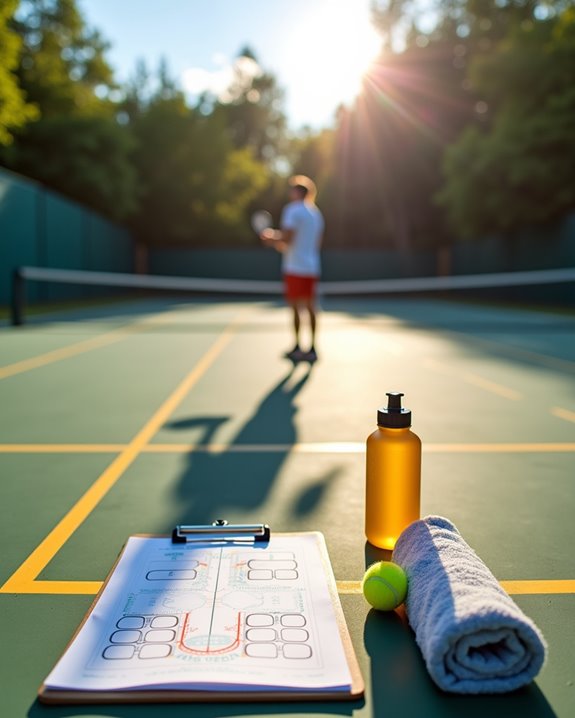
Playing singles in pickleball shifts the recipe entirely! You’re now covering the full 20-foot-wide court by yourself, requiring more strategic movement and energy management. Remember your serving rules: serve from the right when your score is even, left when odd—just like folding ingredients in the proper order.
Singles pickleball: one player, full court, strategic movement. Like a solo chef mastering both sides of the kitchen simultaneously.
Master the two-bounce rule before approaching the non-volley zone. This creates time to position yourself centrally after each shot.
Your tactical approaches should blend power shots (your main course) with soft dinks (your garnish) to keep opponents guessing. When they’re backpedaling from your deep shot, that’s your cue to simmer forward and take control of the kitchen area.
Court coverage comes down to reading your opponent’s body language—anticipate their next move before they serve it up!
Frequently Asked Questions
What Are Pickleball Rules for Beginners?
You’ll need to understand pickleball basics: scoring system starts at zero, only servers score points, play on a 20×44 foot court, and avoid the kitchen (non-volley zone) when hitting volleys with your paddle.
What Are the New 2025 Rules for Pickleball?
Like a kitchen transformed, you’ll notice clearer fault definitions, refined service positioning, and simplified non-volley zone rules in 2025. The updated rulebook includes enhanced safety provisions and more accessible wording for all players.
What Is the Golden Rule Pickleball for Beginners?
The golden rule in pickleball means treating others as you’d want to be treated. As a beginner, focus on pickleball etiquette while learning the scoring system, court dimensions, paddle types, and player positions to avoid common mistakes.
What Are the New Serving Rules for Pickleball?
You’ll need proper foot positioning behind the baseline for your serve. You can use traditional serve height restrictions or try drop serves. Remember, faults occur if you’re in the wrong service sequence or use illegal serving techniques.

